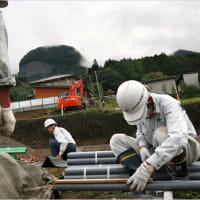
Japan Rethinks a Dam, and a Town Protests - NYTimes.com
Japan Rethinks a Dam, and a Town Protests
By MARTIN FACKLER
NAGANOHARA, Japan ― The clatter of construction machinery still fills this forested mountain gorge, where legions of men in hard hats busily pour concrete, clear hillsides and erect a huge, unfinished bridge whose concrete supports tower over the valley floor like crucifixes in an immense graveyard.
It seems an apt analogy. Japan’s new government has suspended the $5.2 billion Yamba Dam being built here and turned this valley four hours north of Tokyo into a symbolic final resting place for the nation’s postwar order, which relied on colossal public works spending.
The Democratic Party government of Prime Minister Yukio Hatoyama has chosen this dam as the first of 48 national government-financed dams that it wants to scrap, worth tens of billions of dollars. Canceling it is widely seen here as the first major test of the new government’s ability to deliver on campaign promises to revitalize Japan’s ailing economy by ending wasteful projects, and in the process break the grip of the central planners in Tokyo’s powerful ministries.
Decades of pouring concrete have been widely blamed in Japan for cluttering rural areas with needless dams and roads to nowhere. They have also saddled the country with the developed world’s largest national debt ― nearly twice its $5 trillion economy. Mr. Hatoyama’s party has vowed to replace Japan’s postwar “construction state” and the jobs it created with something closer to a European-style social welfare system.
The Democrats, who won a landmark election over the long-ruling Liberal Democratic Party in late August, have also promised to scrap planned airports and highways. But dams are particularly symbolic because they were favored as a means of flood control and power generation by Japan’s central planners, who have dammed almost every major river in the country, some more than once.
Japan had around 60 large dams under construction in 2005, making it the world’s fourth largest dam-building nation, according to The International Journal on Hydropower and Dams, despite having a land area smaller than California’s.
But the Democrats have run into opposition from an unexpected quarter: the small hot springs town of Naganohara, part of which would be submerged by the reservoir created by the dam.
In what has become a David and Goliath battle, the town of 6,400 residents has put the new government on the defensive. Many residents complain that the town’s livelihood now depends on the dam, and particularly the compensation payments and construction jobs that accompany it.
“If the dam gets canceled, how are we going to eat?” asked Naganohara’s mayor, Kinya Takayama, who noted that the dam was first proposed 57 years ago.
Tempers flared last month, when angry residents rejected an offer to meet the new minister in charge of public works, Seiji Maehara, who visited the dam site.
Facing a wave of news coverage sympathetic to the town, Mr. Maehara signaled that even after canceling the dam, Tokyo would finish relocation of the affected townspeople and complete the roads and bridges that will link the new neighborhoods on higher ground.
That construction would cost $850 million, in addition to the $3.6 billion spent on the project so far. This, and about $1.8 billion in compensation that Tokyo might end up paying to Gunma Prefecture, where Naganohara is located, and other local governments could mean that canceling the dam would prove more expensive than completing it.
The ferocity of Naganohara’s opposition has already forced the new government to reconsider the scope of its dam-busting plans. Last Friday, Mr. Maehara said he would consult with local governments to decide whether to cancel an additional 87 nationally subsidized dam projects that he had originally vowed to scrap.
At the center of this costly battle lies what political experts call one of the thorniest legacies of Japan’s enormous public works spending: the near total dependence of local communities on the purse strings of the central government.
While public works spending is down from its 1990s peak, the construction industry continues to dominate the economy, with construction companies this year employing 8 percent of all working Japanese, twice the level in the United States, according to government labor statistics.
Mr. Hatoyama has vowed to cut spending even further, trimming an additional $14 billion this year from Tokyo’s $88 billion public works budget. But political experts say his biggest challenge will be to wean regional communities from their reliance on Tokyo.
“What’s happening at Yamba Dam is actually a revolution in the way Japan is run,” said Takayoshi Igarashi, a professor of politics at Hosei University in Tokyo. “This would end Japan’s structure of dependence on public works and central planning.”
In Naganohara, more than 20 construction companies employ about 400 people ― about 10 percent of working-age residents. Local people say the town has already suffered hundreds of job losses as ballooning national deficits forced cuts in public works earlier this decade by Junichiro Koizumi, then the prime minister.
“I’m not wedded to the idea of building a dam here, but we need the public works to keep everyone employed,” said Katsuyoshi Hoshino, the president of Miyako Construction, based in Naganohara, which has 10 employees.
The town has tried to come up with its own alternatives for creating jobs, like turning the hot springs into a “Diet Valley” of weight-loss spas for young women.
Local people admit that few of their ideas offer the financial benefits of the dam. While many of the town’s original homes on the valley floor seem cramped and run-down, those being built on the mountainside are large and modern, with solar panels on their roofs.
“The dam is like a drug that is making us addicted,” said Takuji Toyoda, 57, who owns a hot-springs inn. “The money keeps pouring in every year to build things for us.”
In fact, some residents blame the dam and its construction for destroying the town’s original economic self-sufficiency by forcing farmers to give up their fields and driving tourists away from the hot springs.
Kichitaro Tomizawa, 69, a rice and vegetable farmer, said he resisted leaving his large, unpainted wooden home because it had been in his family for four generations and was the place where as a 3-year-old he last saw his father, who died in World War II. But he said that once his neighbors started relocating, he had no choice but to follow, because it takes entire communities to maintain the irrigation ducts used for rice farming.
Mr. Tomizawa’s five-acre farm sits near the bottom of one of the huge crucifix-like concrete pillars built to support a $60 million bridge that is to rise 250 feet above the valley floor ― high enough to stand above the reservoir, should it ever take shape.
When pressed, few local people admit to liking the dam. But few can imagine how the town will sustain itself without the project.
“We’ll have to find some other way to survive,” said Mr. Hoshino, the construction company president. “But I can’t see that way now. The future is dark.”
Japan Rethinks a Dam, and a Town Protests
By MARTIN FACKLER
NAGANOHARA, Japan ― The clatter of construction machinery still fills this forested mountain gorge, where legions of men in hard hats busily pour concrete, clear hillsides and erect a huge, unfinished bridge whose concrete supports tower over the valley floor like crucifixes in an immense graveyard.
It seems an apt analogy. Japan’s new government has suspended the $5.2 billion Yamba Dam being built here and turned this valley four hours north of Tokyo into a symbolic final resting place for the nation’s postwar order, which relied on colossal public works spending.
The Democratic Party government of Prime Minister Yukio Hatoyama has chosen this dam as the first of 48 national government-financed dams that it wants to scrap, worth tens of billions of dollars. Canceling it is widely seen here as the first major test of the new government’s ability to deliver on campaign promises to revitalize Japan’s ailing economy by ending wasteful projects, and in the process break the grip of the central planners in Tokyo’s powerful ministries.
Decades of pouring concrete have been widely blamed in Japan for cluttering rural areas with needless dams and roads to nowhere. They have also saddled the country with the developed world’s largest national debt ― nearly twice its $5 trillion economy. Mr. Hatoyama’s party has vowed to replace Japan’s postwar “construction state” and the jobs it created with something closer to a European-style social welfare system.
The Democrats, who won a landmark election over the long-ruling Liberal Democratic Party in late August, have also promised to scrap planned airports and highways. But dams are particularly symbolic because they were favored as a means of flood control and power generation by Japan’s central planners, who have dammed almost every major river in the country, some more than once.
Japan had around 60 large dams under construction in 2005, making it the world’s fourth largest dam-building nation, according to The International Journal on Hydropower and Dams, despite having a land area smaller than California’s.
But the Democrats have run into opposition from an unexpected quarter: the small hot springs town of Naganohara, part of which would be submerged by the reservoir created by the dam.
In what has become a David and Goliath battle, the town of 6,400 residents has put the new government on the defensive. Many residents complain that the town’s livelihood now depends on the dam, and particularly the compensation payments and construction jobs that accompany it.
“If the dam gets canceled, how are we going to eat?” asked Naganohara’s mayor, Kinya Takayama, who noted that the dam was first proposed 57 years ago.
Tempers flared last month, when angry residents rejected an offer to meet the new minister in charge of public works, Seiji Maehara, who visited the dam site.
Facing a wave of news coverage sympathetic to the town, Mr. Maehara signaled that even after canceling the dam, Tokyo would finish relocation of the affected townspeople and complete the roads and bridges that will link the new neighborhoods on higher ground.
That construction would cost $850 million, in addition to the $3.6 billion spent on the project so far. This, and about $1.8 billion in compensation that Tokyo might end up paying to Gunma Prefecture, where Naganohara is located, and other local governments could mean that canceling the dam would prove more expensive than completing it.
The ferocity of Naganohara’s opposition has already forced the new government to reconsider the scope of its dam-busting plans. Last Friday, Mr. Maehara said he would consult with local governments to decide whether to cancel an additional 87 nationally subsidized dam projects that he had originally vowed to scrap.
At the center of this costly battle lies what political experts call one of the thorniest legacies of Japan’s enormous public works spending: the near total dependence of local communities on the purse strings of the central government.
While public works spending is down from its 1990s peak, the construction industry continues to dominate the economy, with construction companies this year employing 8 percent of all working Japanese, twice the level in the United States, according to government labor statistics.
Mr. Hatoyama has vowed to cut spending even further, trimming an additional $14 billion this year from Tokyo’s $88 billion public works budget. But political experts say his biggest challenge will be to wean regional communities from their reliance on Tokyo.
“What’s happening at Yamba Dam is actually a revolution in the way Japan is run,” said Takayoshi Igarashi, a professor of politics at Hosei University in Tokyo. “This would end Japan’s structure of dependence on public works and central planning.”
In Naganohara, more than 20 construction companies employ about 400 people ― about 10 percent of working-age residents. Local people say the town has already suffered hundreds of job losses as ballooning national deficits forced cuts in public works earlier this decade by Junichiro Koizumi, then the prime minister.
“I’m not wedded to the idea of building a dam here, but we need the public works to keep everyone employed,” said Katsuyoshi Hoshino, the president of Miyako Construction, based in Naganohara, which has 10 employees.
The town has tried to come up with its own alternatives for creating jobs, like turning the hot springs into a “Diet Valley” of weight-loss spas for young women.
Local people admit that few of their ideas offer the financial benefits of the dam. While many of the town’s original homes on the valley floor seem cramped and run-down, those being built on the mountainside are large and modern, with solar panels on their roofs.
“The dam is like a drug that is making us addicted,” said Takuji Toyoda, 57, who owns a hot-springs inn. “The money keeps pouring in every year to build things for us.”
In fact, some residents blame the dam and its construction for destroying the town’s original economic self-sufficiency by forcing farmers to give up their fields and driving tourists away from the hot springs.
Kichitaro Tomizawa, 69, a rice and vegetable farmer, said he resisted leaving his large, unpainted wooden home because it had been in his family for four generations and was the place where as a 3-year-old he last saw his father, who died in World War II. But he said that once his neighbors started relocating, he had no choice but to follow, because it takes entire communities to maintain the irrigation ducts used for rice farming.
Mr. Tomizawa’s five-acre farm sits near the bottom of one of the huge crucifix-like concrete pillars built to support a $60 million bridge that is to rise 250 feet above the valley floor ― high enough to stand above the reservoir, should it ever take shape.
When pressed, few local people admit to liking the dam. But few can imagine how the town will sustain itself without the project.
“We’ll have to find some other way to survive,” said Mr. Hoshino, the construction company president. “But I can’t see that way now. The future is dark.”











![99歳のお婆さんの詩集「くじけないで]](https://blogimg.goo.ne.jp/image/upload/f_auto,q_auto,t_image_square_m/v1/user_image/2d/c0/0a6bfc72611d94be6342873f21567bb8.jpg)








※コメント投稿者のブログIDはブログ作成者のみに通知されます